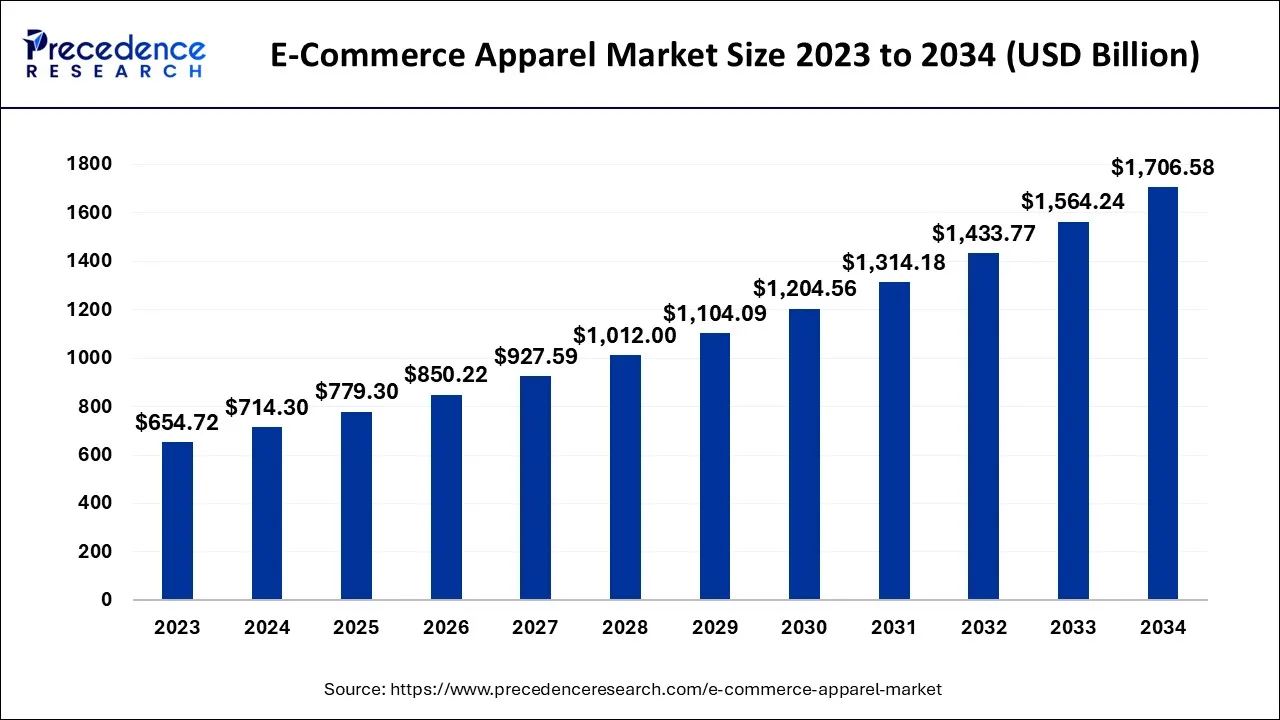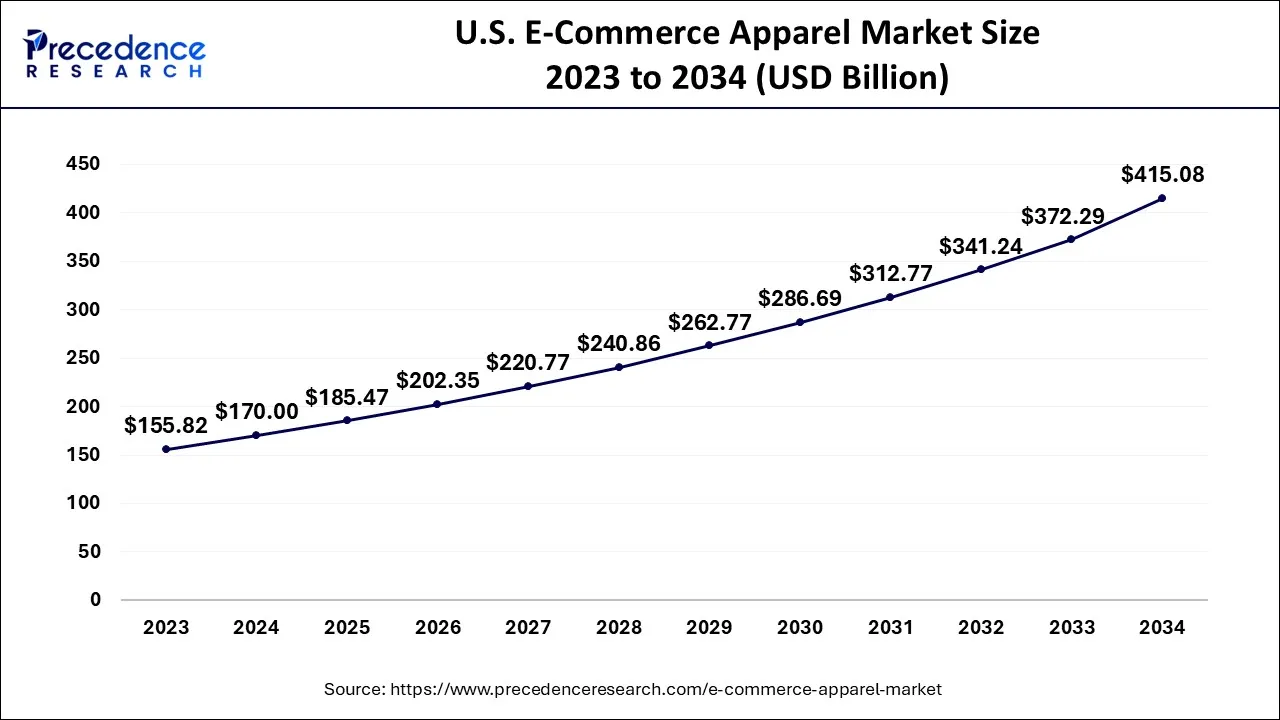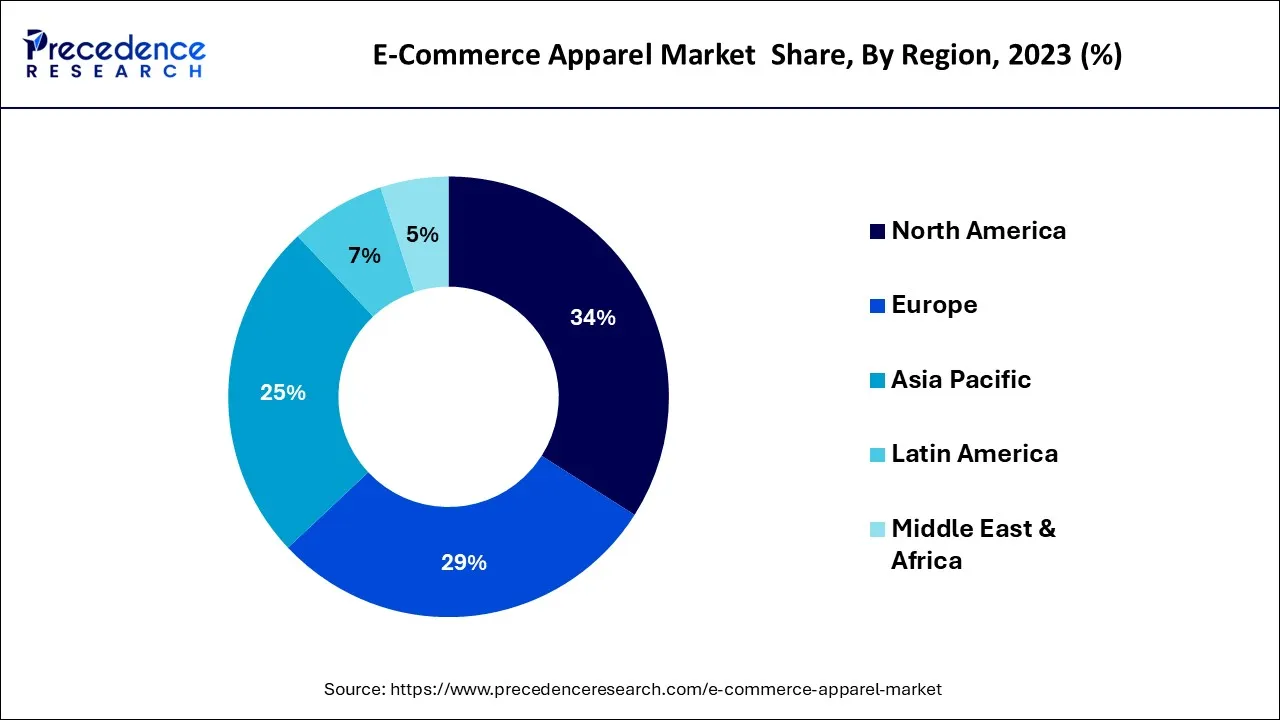August 2025
The global e-commerce apparel market size was estimated at USD 714.30 billion in 2024, and is projected to hit USD 779.30 billion by 2025, and is anticipated to reach around USD 1,706.58 billion by 2034, expanding at a CAGR of 9.10% over the forecast period 2025 to 2034.

The U.S. e-commerce apparel market size was exhibited at USD 170.00 billion in 2024 and is projected to be worth around USD 415.08 billion by 2034, growing at a CAGR of 9.34% from 2025 to 2034.

North America dominates the global e-commerce apparel market, the region is expected to sustain its dominance throughout the forecast period. The e-commerce apparel market in North America has been experiencing strong growth, driven by factors such as convenience, greater variety and selection, and competitive pricing.
Online shopping in the United States reached $1.7 trillion in the duration of 2020-2022, which represents a 55% increase in online shopping. Considering the rising number of online shoppers in the region, the United States is observed to be the most significant contributor to the market’s growth, followed by Canada. The most prominent e-commerce apparel companies, including Amazon, Walmart, Nike, Macy’s, and Target, are based in the United States. The presence of such significant players plays an active role in the development of the market.

The e-commerce apparel market in Asia-Pacific is one of the largest and fastest-growing in the world, driven by factors such as rising disposable incomes, a growing middle class, and the increasing popularity of online shopping. China is the largest e-commerce market in the region, accounting for a significant share of total e-commerce apparel sales. As the technology becomes widely accepted by the developing countries of Asia Pacific, the e-commerce apparel market is intended to show significant growth in the region. Retailers in Asia are investing in livestream offerings, innovative services, diverse payment options, and risk management protocols; these factors are promoting the growth of the market in the region.
Moreover, the rising investments in warehouses and logistics in developing countries are fueling the market's growth. Beyond the increased demand for online shopping, sophisticated logistics services, a smooth supply chain, and the availability of diverse sources for online shopping are a few other factors to propel the market growth in Asia Pacific during the forecast period.
Europe e-commerce apparel market is growing at notable rate. Mobile-compatible platforms, seamless payment methods, and AI-enhanced personalization enhance user experience, boosting online apparel sales and regional market expansion. In 2023, the value of European mobile fashion commerce reached €89.6 billion, with smartphones representing 67% of total online fashion sales. Consumers seek sustainable materials, responsible sourcing, and transparent supply chains. Brands adopting sustainable practices boost market presence, enhance customer loyalty and regulatory adherence, and elevate long-term profitability. The apparel market in Europe sees cross-border e-commerce fueled by growing consumer interest in global brands, enhanced logistics, and simplified customs processes, broadening market access and boosting revenue prospects for online fashion merchants. European online clothing brands are increasingly utilizing AR-enabled virtual fitting rooms to assist customers in visualizing how garments will fit and look prior to buying. This innovation connects physical retail with digital shopping experiences, reducing return rates, enhancing customer confidence, and boosting online sales.
The e-commerce apparel market refers to the online market for clothing and accessories. It involves buying and selling these products through various online platforms, such as online marketplaces, e-commerce websites, and social media platforms. The e-commerce apparel market has experienced significant growth in recent years, driven by factors such as the increasing use of mobile devices, the convenience of online shopping, and the availability of a broader range of products and styles than what may be available in physical stores.
The e-commerce apparel market is expected to witness a significant shift during the forecast period with the rising preferences for online shopping. More consumers are turning to online shopping for their clothing and accessory needs as e-commerce becomes more widespread and convenient. Online shopping offers a broader range of products and styles, as well as the convenience of shopping from home.
The increasing use of mobile devices, such as smartphones and tablets, has made it easier for consumers to shop online, even while on the go. Many e-commerce apparel retailers have optimized their websites and apps for mobile devices, making it easier and more convenient for customers to browse and shop on their mobile devices.
The rising influence of social media all across the globe is observed as a significant growth factor for the market. Social media platforms have become an important marketing and sales channel for e-commerce apparel retailers, with influencers and user-generated content helping to drive sales. E-commerce apparel retailers can reach a global audience, allowing them to expand their customer base beyond their local markets. Thus, the convenience offered by such platforms for retailers to expand their businesses across the world is fueling the growth of the e-commerce apparel market.
Advancements in e-commerce technology, such as augmented reality and virtual reality, have made it easier for customers to visualize clothing and accessories before making a purchase, improving the online shopping experience. Advances in logistics and fulfillment technologies have made it easier and more cost-effective for e-commerce apparel retailers to manage their supply chains and ship products to customers quickly and affordably.
| Report Coverage | Details |
| Market Size by 2034 | USD 1,706.58 Billion |
| Market Size in 2025 | USD 779.30 Billion |
| Market Size in 2024 | USD 714.30 Billion |
| Growth Rate from 2025 to 2034 | CAGR of 9.10% |
| Largest Market | North America |
| Base Year | 2024 |
| Forecast Period | 2025 to 2034 |
| Segments Covered | Type, and Region |
| Regions Covered | North America, Europe, Asia-Pacific, Latin America, and Middle East & Africa |
Rising marketing strategies by social media influencers
Social media influencer marketing is considered one of the most highly effective methods for e-commerce apparel brands to reach a wider audience, drive sales and build brand awareness. Influencers promote e-commerce apparel brands and their products to their large social media followings, increasing the reach and visibility of the brand and its products.
Multiple e-commerce apparel brands are effectively targeting their marketing efforts by partnering with influencers. Influencers that create engaging content by incorporating consumer interests are expected to drive traffic towards e-commerce brands in an organic way; this is observed to act as a significant driver for the market’s growth in the upcoming period.
Risks associated with cybersecurity
E-commerce apparel retailers process and store large amounts of personal and financial data, including credit card numbers, addresses, and phone numbers. A data breach can result in the loss of sensitive customer information, leading to financial losses and reputational damage. Phishing scams can target e-commerce apparel retailers and their customers, attempting to steal login credentials and other sensitive information. Phishing emails and fake websites can be used to trick customers into entering their personal and financial information. The risk associated with cybersecurity limits consumers from shopping at e-commerce websites; this acts as a significant restraint for the growth of the e-commerce apparel market.
In August 2022, United States-based North Face, a prominent manufacturer of outdoor clothing, footwear, and accessories, stated that the company’s corporate e-commerce website had suffered from a credential cyberattack, where the hackers can utilize authentication credentials, including phone number, email address, and passwords in order to get unauthorized access to consumes’ accounts.
The deployment of artificial intelligence (AI) technology
According to a report published by McKinsey, companies that excel in personalization generate 40% more revenue than average players. The same research stated that consumers expect to receive personalized services while shopping online.
The deployment of artificial intelligence AI in the e-commerce apparel market is expected to open several opportunities for retailers to improve personalization, optimize inventory management, pricing, and customer service, and enhance security. AI-powered chatbots can provide automated customer service, helping customers with their queries and concerns 24/7. This can improve customer satisfaction and reduce the workload of customer service representatives. AI can be used to analyze pricing data and optimize pricing strategies to maximize revenue. This can help e-commerce apparel retailers to set competitive prices and increase profitability. AI can be used to optimize inventory management, predict demand, and automate the restocking process. This can help e-commerce apparel retailers to reduce inventory costs and increase efficiency.
For instance, In March 2022, Walmart announced the launch of an AI-powered virtual clothing try-on service for online shoppers, especially for Walmart’s mobile app. The virtual technology service offers try-on for sizes XS to XXXL; the company aims to expand its model range in the upcoming period.
The women's apparel segment accounted for the largest share in 2024, and the segment is expected to maintain its dominance during the forecast period. Women's clothing tends to offer more variety in terms of styles, designs, and colors, making it more appealing to online shoppers who have access to a broader range of options.
E-commerce websites often offer more competitive prices on women's apparel than traditional brick-and-mortar stores, which can be a significant factor in attracting customers. Women's apparel is also heavily promoted on social media platforms and through influencer marketing campaigns, which can help generate buzz and increase visibility for these products. The women's apparel category carries a more significant segment of retailers and brands; this has led to additional investments in the women's apparel category.
The men’s apparel segment is observed as the rapidly growing segment in the global market. With the rising number of online shoppers, multiple brands are focused on offering specialized apparel websites for men. The continuous growth in men’s luxurious apparel options is another factor to boost the segment’s growth.
In February 2024, Kerala-based apparel start-up, Giacca & Abito announced the launch of its online portal for apparel shopping, Tea & Tailoring. The newly launched e-commerce apparel website aims to provide premium clothing solutions, especially for men. The e-commerce platform will be offering premium innerwear, home textiles, and more.
The kids apparel segment is another attractive segment of the market, expected to witness a noticeable growth during the forecast period. With the rising number of people preferring online shopping, multiple brands launching clothing ranges for kids and expansion of e-commerce apparel businesses across the globe are observed to fuel the growth of the segment. With the launch of the kid's apparel range on e-commerce platforms, brands are focusing on differentiating themselves in the market.
By Type
By Region
For inquiries regarding discounts, bulk purchases, or customization requests, please contact us at sales@precedenceresearch.com
No cookie-cutter, only authentic analysis – take the 1st step to become a Precedence Research client
August 2025
July 2025
June 2025
July 2025